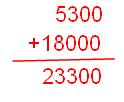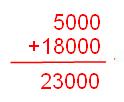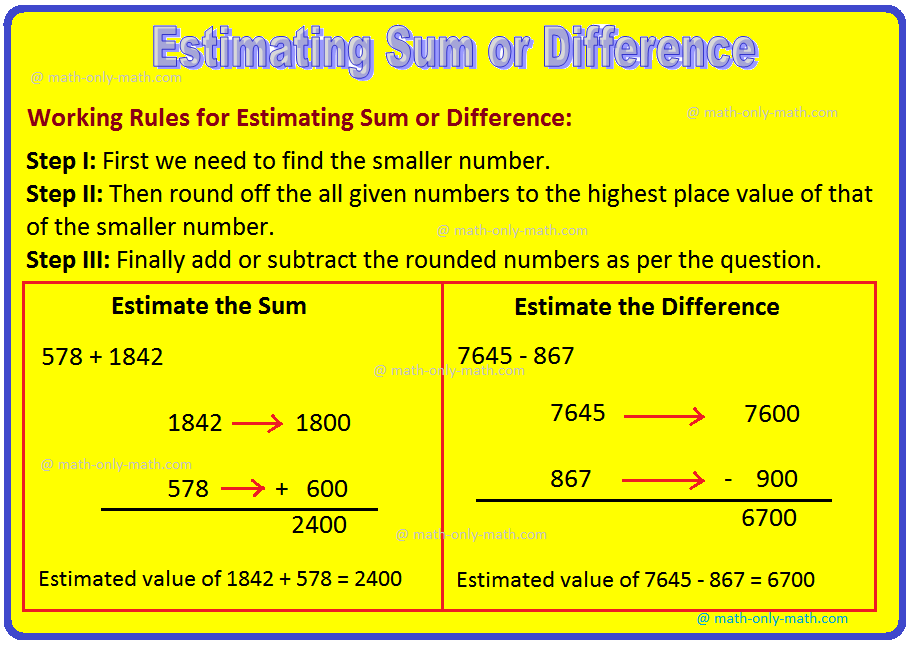Subscribe to our ▶️ YouTube channel 🔴 for the latest videos, updates, and tips.
Estimating Sum and Difference
The procedure of estimating sum and difference are in the following examples.
Working Rules for Estimating Sum or Difference:
Step I: First we need to find the smaller number.
Step II: Then round off the all given numbers to the highest place value of that of the smaller number.
Step III: Finally add or subtract the rounded numbers as per the question.
Solved Examples on Estimating Sum or Difference:
1. Estimate the sum 5290 + 17986 by estimating the numbers to their nearest (i) hundreds (ii) thousands.
Solution:
(i) Estimating the numbers 5290 and 17986 to their nearest hundreds, we get 5300 and 18000 respectively.
We have,
Therefore, estimated sum is 23300.
(ii) Estimating the numbers 5290 and 17986 to their nearest
hundreds, we get 5000 and 18000 respectively.
We have,
Therefore, estimated sum is 23000.
2. Estimate: 5673 – 436 by rounding off the numbers to their greatest places. Also,, find the reasonable estimate.
Solution:
We have, 5673 – 436 = 5237.
The greatest place in 5673 is thousands place and in 436 the greatest place is hundred place.
Estimating 5673 to nearest thousands, we get 6000
Estimating 436 to nearest hundreds, we get 400
Therefore estimated difference = 6000 – 400 = 5600
Clearly, it is not closer to the actual difference. So, it is not a reasonable estimate.
Let us round off 5673 and 436 to nearest hundreds.
5673 rounds off as 5700.
436 rounds off as 400
Therefore estimated difference = 5700 – 400 = 5300
3. Give a rough estimate and also a closer estimate of 489342 – 48365.
Solution:
We have,
489342 – 48365 = 440877
To find rough estimate, let us round off each number to nearest ten thousands.
489342 rounds off as 490000
48365 rounds off as 50000
Estimates difference = 490000 – 50000 = 440000
So, rough estimate = 440000
In order to obtain a closer estimate, let us round off each number to nearest thousands.
489342 rounds off as 489000
48365 rounds off as 48000
Estimated difference = 489000 – 48000 = 441000
Clearly, it is closer to the actual difference 440977
Hence, closer estimate is 441000
4. Estimate the following Sum or Difference:
(i) 578 + 1842
(ii) 8435 - 597
Solution:
(i) Estimate the sum of 578 + 1842
Out of 578 and 1842, the smaller number is 578.
Hence, we have to round off both the numbers (578 and 1842) to the nearest hundred.
578 to the nearest hundred = 600
1842 to the nearest hundred = 1800
|
1842 |
→ |
1800 | |||
|
578 |
→ |
+ 600 | |||
|
2400 |
Estimated value of 1842 + 578 = 2400
(ii) Estimate the difference of 7645 - 867
Out of 867 and 7645, the smaller number is 867.
Hence, we have to round off both the numbers (867 and 7645) to the nearest hundred.
867 to the nearest hundred = 900
7645 to the nearest hundred = 7600
|
7645 |
→ |
7600 | |||
|
867 |
→ |
- 900 | |||
|
6700 |
Therefore, the estimated value of 7645 - 867 = 6700.
Worksheet on Estimating Sum and Difference:
1. Estimate the following:
(i) 243 + 4272
(ii)145 + 2478
(iii) 1248 - 167
(iv) 8465 - 1234
(v) 243 + 1252
(vi) 2431 + 142
(vii) 243 + 178
(viii) 4217 - 398
Answer:
1. (i) 4500
(ii) 2600
(iii) 1000
(iv) 7300
(v) 1500
(vi) 2500
(vii) 400
(viii) 3800
2. Two different size of petrol tanks contain 6325 ℓ and 4890 ℓ water respectively. What is the estimated difference of petrol in the two tanks to the nearest hundred?
Solution:
7325 ℓ → 7300 ℓ (Round off to the nearest hundreds)
4890 ℓ → 4900 ℓ (Round off to the nearest hundreds)
The estimated difference of petrol in the two tanks = (7300 - 4900) ℓ
= 2400 ℓ
Therefore the required estimated difference = 2400 ℓ
● Estimate
Estimating Product and Quotient
6th Grade Page
From Estimating Sum and Difference to HOME PAGE
Didn't find what you were looking for? Or want to know more information about Math Only Math. Use this Google Search to find what you need.





New! Comments
Have your say about what you just read! Leave me a comment in the box below. Ask a Question or Answer a Question.